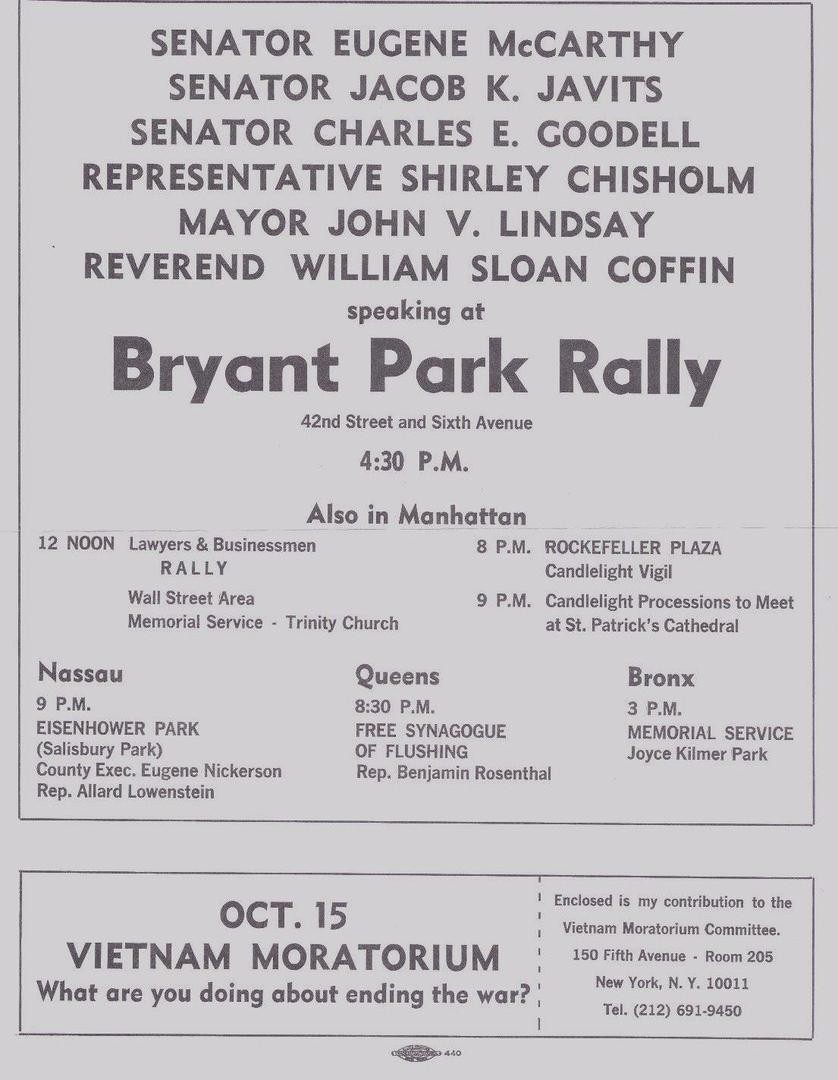“The media and reality: It's hard to attend both."
Tony Conrad Collection no. 13)
Tony Conrad
Bryant Park Moratorium Rally (1969)
2003/2005
Tony Conrad's Audio ArtKive/
Table of the Elements
[Bismuth] TOE-MP-83/TOE-CD-83
Free mp3/compact disc, matte varnish, matte enclosure, watermarked typing paper
An October afternoon in 1969. Midtown Manhattan. A rally in Bryant Park against the Vietnam War. Down 42nd Street towards Times Square, Tony Conrad is adjusting microphones in his 5th floor loft, one directed at the TV set—where it will pick up live local news coverage—the other pointing out the window, where the echo of speeches and crowd noise mingles with the oceanic rush of crosstown traffic. As the event is about to begin, he rolls tape. Thirty-four years later, we hear what he heard. And the juncture, for so many reasons, could not be more critical. As the Bush Administration pursues a risky military agenda in the Middle East—one with unsettling long-term implications both at home and abroad—we see a nation not divided, as in the Vietnam Era, but strangely complacent. Our media-saturated reality functions like a drug, instantly televised warfare a new entertainment, and organized public dissent a novelty at home and a roaring chorus everywhere else. Conrad's recording of the Oct. 15 Vietnam Moratorium Rally is an eerie flashback that offers urgent new insights into our own lives and times, post-9/11 and full on into a new millennium.
"This was one event that I didn't have to leave the house to attend," says Conrad, whose recording coincidentally chronicles not only the rally—an archival moment—but doubles as a kind of sonic residue of a New York City that doesn't quite exist anymore, a place as swept away by the tilt of time and the circumstance of history as the twin towers. The Times Square area, now a Disneyfied circus of commerce suitable for morning show wallpaper, once was something far scarier and more radically chaotic. And it was from this perch that Conrad spent the afternoon. He remembers: "The street was awash with humanity, but no one lived there. It was like being in a desert in some ways. The number of voters were very small. There were people of every stripe and pandering to every kind of base and debased desire. There was a huge crossover, because millions of people came to work there every day, but it was also skin deep. People lived at the edge of the gutter."
The perfect place to make your life as an artist, amid the democratic bustle. That ruckus is key to this recording, which indulges the composer's interest in issues of documentation, the nature of public spectacles, and the deep biological impulses that govern the individual's response in the face of a mass. "What quickens your pulse in the wake of thousands and thousands of people?" he asks, while holding up this construct to a dual one. "That phenomenon of somehow the abstract voice of the media that comes down to us, can shape individual reality."
With that in mind, listen to how the two channels of this tape define the gap between media (the instantaneous leap of audio from a microphone in the park, transformed into a signal, and broadcast through his television's speaker) and reality (the delayed and muffled arrival of the same information at his window). It was funny, Conrad notes: "Because being there is later than TV. This brings up the phenomenological notion of the present, whether we live in it or after it. So you have this situation of TV vs. live, or TV vs. the street, all these issues of presence. The tape invokes that time really accurately and thoroughly. It's a big chunk, and that makes things so much more different than a sound byte."
The rally, part of that date's full slate of public demonstrations against the war, proves to be at once poignant and a bit comical. Powerful oratory from the Rev. William Sloan Coffin (who cites the gospel according to Pogo: "We have met the enemy, and he is us.") shares time with quips from Rod McEuen. A stageful of Broadway stars enjoy cameos ("Dick Benjamin!"), while Dick Cavett and Woody Allen chime in with quick comments. Leading anti-war politicos—such as Eugene McCarthy and Shirley Chisholm—take the microphone. It's a remarkable day in the life of a city.
"People really owe it to themselves to go to these things," Conrad says. "Because these occasions are such important markers of the events of our time. The moratorium rally put the media and the people side-by-side, and presents a very important idea that comes into the picture in today's protests as well. The media and reality: It's hard to attend both."
Steve Dollar
New York City
August, 2003







